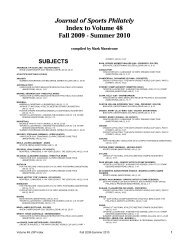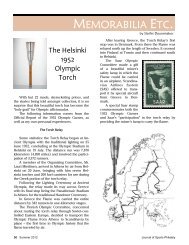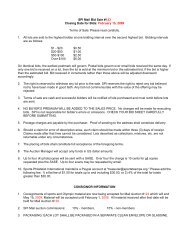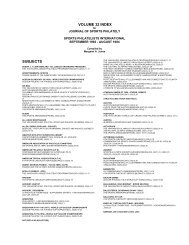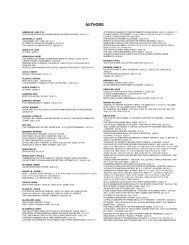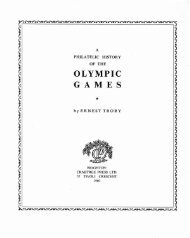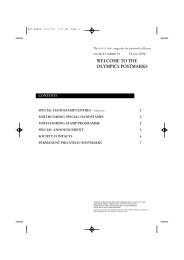APS Baseball stamp album - Sports Philatelists International
APS Baseball stamp album - Sports Philatelists International
APS Baseball stamp album - Sports Philatelists International
You also want an ePaper? Increase the reach of your titles
YUMPU automatically turns print PDFs into web optimized ePapers that Google loves.
U.S. <strong>Baseball</strong><strong>Baseball</strong> centennialScott 855 • 1939“Base-ball” is mentioned by name, illustrated, and described in a 1744 Britishbook, and a 1791 bylaw in Pittsfield, Massachusetts, prohibited playing it within80 yards of the newly built town meeting house. However, Abner Doubledayis credited for creating the game in 1839, with the first game taking place inCooperstown, New York.Grandma Moses July FourthScott 1370 • 1969Reproducing the design of a 1951 painting by thethen-91-year-old folk artist, this <strong>stamp</strong> shows anidealized, early version of the July fourth holiday.As its centerpiece, it shows four boys playingbaseball on a green field, a detail from the fullpainting that depicts festive picnicking, fireworks,flag-waving revelers, and a band.“Take me out to the ball game”Scott 4341 • 2008Written by Jack Norworth, “Take Me Out tothe Ball Game” celebrated its centennial in2008. For decades, the song’s catchy chorus hasbeen part of the musical tradition at ballparksaround the country, especially during theseventh-inning stretch. The <strong>stamp</strong> image isadapted from a late 19th-century baseball“trade card.”Folks HeroesMighty CaseyScott 3083 • 1996In the poem by Ernest Thayer, “Casey at the Bat: A Ballad of the Republic Sungin the Year 1888,” Mighty Casey is part of a fictional baseball team. The poemwas first recorded in 1893. In 1920 the poem was turned into a song and it wasadapted into a film in 1927. Since then, there have been animated film, opera,and novel adaptations of this popular poem.© 2012 — The Scott numbers are the copyrighted property of Amos Press Inc., dba Scott Publishing Co.and are used here under a licensing agreement with Scott.The marks “Scott” and “Scott’s” are Registered in the U.S. Patent and Trademark Office,and are trademarks of Amos Press, Inc. dba Scott Publishing Co.No use may be made of these marks or of material in this publication, which is reprintedfrom a copyrighted publication of Amos Press, Inc., without the express written permission of Amos Press, Inc.,dba Scott Publishing Co., Sidney, Ohio 45365.<strong>Baseball</strong> • Page 2American Philatelic Society, www.<strong>stamp</strong>s.org
U.S. <strong>Baseball</strong><strong>Baseball</strong> centennialScott 855 • 1939Grandma Moses July FourthScott 1370 • 1969“Take me out to the ball game”Scott 4341 • 2008Folks HeroesMighty CaseyScott 3083 • 1996American Philatelic Society, www.<strong>stamp</strong>s.org<strong>Baseball</strong> • Page 3
U.S. <strong>Baseball</strong>Youth Team <strong>Sports</strong><strong>Baseball</strong>Scott 3402 • 2000Youth baseball is quite popular inthe United States, as well as scoresof other countries around the world.Informal pick-up games are commonin many towns, while team playis organized through Babe Ruth<strong>Baseball</strong>, Little League, AmericanLegion Youth <strong>Baseball</strong>, and more.Professional <strong>Baseball</strong> CentennialScott 1381 • 1969The Cincinnati Red Stockings, established in 1869,became the first professional baseball team. Thefirst national major league was formed in 1871, butdisbanded in 1875. There are two major leagues inexistence today — the National League was foundedin 1876 and the American League in 1901.Negro LeaguesAndrew “Rube” Foster (1879–1930)Scott 4465 • 2010Scott 4466 • 2010The Negro Leagues <strong>Baseball</strong> <strong>stamp</strong>s pay tribute to the all-black professional baseball leaguesthat operated from 1920 to about 1960. Drawing some of the most remarkable athletesever to play the sport, the Negro leagues galvanized African-American communities acrossthe country, challenged racist notions of athletic superiority, and ultimately sparked theintegration of American sports. In 1920, Andrew “Rube” Foster — who began his baseballcareer as a pitcher — established the Negro National League, the most successful league ofAfrican-American teams. He is considered the “father” of Negro leagues baseball.Olympic <strong>Baseball</strong>Scott 2619 • 1992<strong>Baseball</strong> debuted unofficially at the 1904Summer Games and has been playedcompetitively in 12 Olympiads, with teamsfrom a total of 17 different nations competing.In 1992, the <strong>International</strong> Olympic Committeefinally granted the sport full medal status. TheU.S. won the Gold medal at Sydney in 1992,although Cuba has captured the Gold Medalthree times to date.<strong>Baseball</strong> • Page 4American Philatelic Society, www.<strong>stamp</strong>s.org
U.S. <strong>Baseball</strong>Professional <strong>Baseball</strong> CentennialScott 1381 • 1969Youth Team <strong>Sports</strong><strong>Baseball</strong>Scott 3402 • 2000Negro LeaguesAndrew “Rube” Foster (1879–1930)Scott 4465 • 2010 and Scott 4466 • 2010Olympic <strong>Baseball</strong>Scott 2619 • 1992American Philatelic Society, www.<strong>stamp</strong>s.org<strong>Baseball</strong> • Page 5
U.S. <strong>Baseball</strong>Jim Thorpe (1888–1953)Scott 2089 • 1984James Frances Thorpe excelled in several sports,including baseball. He began his Major Leaguecareer with the National League champion NewYork Giants in 1912. During the winter of 1913–14,Thorpe, along with the Giants and Chicago WhiteSox, barnstormed across the U.S. and then Asia,the Middle East, and Europe. Jim Thorpe was thereal celebrity on this tour.Babe Ruth (1895–1948)Scott 2046 • 1983Celebrate the Century 1920sScott 3184a • 1998George Herman “Babe” Ruth, Jr. began hisprofessional baseball career with the minor leagueBaltimore Orioles, but was soon moved into themajor leagues. He began his career as a pitcher,but was made an outfielder so he could use battingskills in every game. Over his career, Babe Ruthhad many record-breaking performances. Heearned records for the most years leading a leaguein home runs (12); the most total bases in a season(457); the highest batting percentage for a season(.847), and the most career home runs (714).Lou Gehrig (1903–1941)Scott 2417 • 1989One of Lou Gehrig’s most notableaccomplishments was playing in 2,130 consecutivegames over a 15-season span, from 1925 through1939. He was selected to each of the first sevenAll-Star games, and won the American League’sMost Valuable Player Award in 1927 and again in1936. He also led the American League in battingaverage, runs batted in, and home runs in 1934.Gehrig was elected to the <strong>Baseball</strong> Hall of Fame in1939.Jackie Robinson (1919–1972)Scott 2016 • 1982Celebrate the Century 1940sScott 3186c • 1999Hall of Famer Jackie Robinson was the firstAfrican-American to break the color barrier inprofessional baseball when he took his position onEbbets Field in Brooklyn for the Dodgers on April15, 1947. He was selected as the National League’sMost Valuable Player in 1949. Robinson was anexceptional base runner and even stole home19 times in his career. He was inducted into the<strong>Baseball</strong> Hall of Fame in 1962.Roberto Clemente (1934–1972)2097 • 1984Roberto Clemente was drafted by the PittsburghPirates in 1955. This right fielder had an impressivelifetime batting average of .317. With more than3,000 base hits over his career, Clemente earnedfour National League batting championships, wasthe National League Most Valuable Player in 1966,and the World Series Most Valuable Player in 1971.Roger Maris (1934–1985)Celebrate the Century 1960sScott 3188n • 1999Roger Eugene Maras (he changed the spellingof his last name) joined the major leagues in1957. Just a few days after the start of the season,he hit the first home run of his career, a grandslam. In 1960, Maris won the Gold Glove Award(as an outstanding defensive outfielder) and theAmerican League’s Most Valuable Player. Thefollowing year, he hit a record 61 home runs, wonthe American League’s MVP Award for the secondstraight year, and was named the top professionalathlete of the year.<strong>Baseball</strong> • Page 6American Philatelic Society, www.<strong>stamp</strong>s.org
U.S. <strong>Baseball</strong>Jim ThorpeScott 2089 • 1984Babe RuthScott 2046 • 1983Celebrate the Century 1920sScott 3184a • 1998Lou GehrigScott 2417 • 1989Jackie RobinsonScott 2016 • 1982Celebrate the Century 1940sScott 3186c • 1999Roberto Clemente2097 • 1984Roger MarisCelebrate the Century 1960sScott 3188n • 1999American Philatelic Society, www.<strong>stamp</strong>s.org<strong>Baseball</strong> • Page 7
U.S. <strong>Baseball</strong><strong>Baseball</strong> SluggersRoy Campanella (1921–1993)Scott 4080 • 2006One of the greatest catchers in baseball history,Roy Campanella was a standout in Negro Leagueand Mexican League baseball before his debutwith the Brooklyn Dodgers in 1948, a year afterJackie Robinson. With 2,423 home runs, he playedin every All-Star Game from 1949 to 1956, andreceived the National League Most Valuable PlayerAward in 1951, 1953, and 1955.Hank Greenberg (1911–1986)Scott 4081 • 2006A premier power hitter of his generation,“Hammerin’ Hank” Greenberg was one of thefirst outstanding Jewish athletes in Americanprofessional sports — a five-time All-Star and twotimeAmerican League Most Valuable Player. TheDetroit Tiger first baseman had a career battingaverage of .313, with 331 home runs, and 1,276runs batted in.Mel Ott (1909–1958)Scott 4082 • 2006New York Giant right fielder from 1926 to 1947,Melvin Thomas “Mel” Ott was the first NationalLeague player to surpass 500 home runs. A 12-timeAll-Star, Ott compiled a career batting averageof .304, with 511 runs and 2,876 runs batted in.He was so feared by pitchers that he also led theNational League in bases on balls (walks) for sixseasons.Mickey Mantle (1931–1995)Scott 4083 • 2006In 18 seasons, New York Yankee outfielder MickeyMantle won three American League Most ValuablePlayer titles, played on 16 All-Star teams, 12pennant winners, and seven World Championshipclubs. A clutch player, Mantle still holds WorldSeries records for most home runs (18), runsbatted in (40), walks (43), extra-base hits (26), andtotal bases (123).<strong>Baseball</strong> • Page 8American Philatelic Society, www.<strong>stamp</strong>s.org
U.S. <strong>Baseball</strong><strong>Baseball</strong> SluggersRoy CampanellaScott 4080 • 2006Hank GreenbergScott 4081 • 2006Mel OttScott 4082 • 2006Mickey MantleScott 4083 • 2006American Philatelic Society, www.<strong>stamp</strong>s.org<strong>Baseball</strong> • Page 9
U.S. <strong>Baseball</strong>[From the back of the sheet of <strong>stamp</strong>s]Jackie Robinson (Jack Roosevelt Robinson: 1919–1972)Scott 3408a • 2000“Jackie Robinson broke the Major League <strong>Baseball</strong> color barrier when hecame to the Brooklyn Dodgers in 1947. Two years later, he hit a leagueleading.342, drove in 124 runs, and was voted the Most Valuable Playerin the National League.”Eddie Collins (Edward Trowbridge Collins, Sr.: 1887–1951)Scott 3408b • 2000“Eddie ‘Cocky’ Collins played the game of baseball for 25 seasons, a 20thcenturyrecord for nonpitchers. His brilliant baserunning and battinghelped four teams win World Championships.”Christy Matthewson (Christopher Mathewson: 1880–1925)Scott 3408c • 2000“In 1901, 21-year-old Christy Matthewson won 20 games for the NewYork Giants. With his ‘fadeaway’ pitch, he posted three consecutive30-victory seasons and in the 1905 World Series threw three shutouts inonly six days.”Ty Cobb (Tyrus Raymond Cobb: 1886–1961)Scott 3408d • 2000“Known for his aggressive style at the plate and on the base paths, TyCobb may have been the greatest all-around player in Major League<strong>Baseball</strong>. In his 24-year career, 22 with the Detroit Tigers, the ‘GeorgiaPeach’ won 9 straight American League batting titles.”George Sisler (George Harold Sisler: 1893–1973)Scott 3408e • 2000“The St. Louis Browns’ George Sisler won two batting titles, set the recordfor hits in a season, and produced a 41-game hitting streak — all whilemaintaining a reputation as one of the true gentlemen in Major League<strong>Baseball</strong>.”Rogers Hornsby (Rogers Hornsby, Sr.: 1896–1963)Scott 3408f • 2000“Rogers Hornsby was the most impressive right-handed hitters in thehistory of the game. He won seven batting championships (six in arow) and managed the 1926 St. Louis Cardinals to their first WorldChampionship.”Mickey Cochrane (Gordon Stanley Cochrane: 1903–1962)Scott 3408g • 2000“Mickey Cochrane sparked the Philadelphia Athletics’ championshipteams in 1929–1931 with his potent bat, skill behind the plate, and fierce,competitive spirit.”Babe Ruth (George Herman Ruth, Jr.: 1895–1948)Scott 3408h • 2000“Babe Ruth was the most celebrated athlete of his time. Before beginningplay with the New York Yankees in 1920, the ‘Sultan of Swat’ was asuccessful pitcher for the Boston Red Sox. In 1927, he hit a record-setting60 homers.”Walter Johnson (Walter Perry Johnson: 1887–1946)Scott 3408i • 2000“Walter ‘Big Train’ Johnson used a sweeping sidearm motion to firefastballs over home plate. In his 21-year career with the WashingtonSenators, he fanned 3,509 batters, won 417 games, and pitched a record100 shutouts.”Roberto Clemente (Roberto Clemente Walker: 1934–1972)Scott 3408j • 2000“The first Hispanic elected to the Hall of Fame,Roberto Clemente was admired for his superb hitting,rifle-like arm, and philanthropic spirit. He helped the Pittsburgh Pirateswin two World Championships.”Lefty Grove (Robert Moses Grove: 1900–1975)Scott 3408k • 2000“One of the finest left-handed pitchers in the history of Major League<strong>Baseball</strong>, Lefty Grove went 31-4 for the 1931 Philadelphia Athletics. Inthe process, he put together a 16-game winning streak.”Tris Speaker (Tristram E. Speaker: 1888–1958)Scott 3408l • 2000“Tris Speaker revolutionized outfield play by positioning himself inshallow center field. As a result, this Cleveland Indian recorded moreassists than any other outfielder in the long history of Major League<strong>Baseball</strong>.”Cy Young (Denton True Young: 1867– 3408m • 2000“Denton True Young, nicknamed Cy (short for ‘Cyclone’), won 511 gamesin his 22-year Major League <strong>Baseball</strong> career — almost 100 more thanany other pitcher. A durable athlete, Young pitched an astonishing 749complete games.”Jimmie Foxx (James Emory Foxx: 1907–1967)Scott 3408n • 2000“One of the top Major League <strong>Baseball</strong> sluggers of all time, Jimmie Foxxhit 30 or more home runs for 12 seasons in a row. Foxx won the TripleCrown for the Philadelphia Athletics in 1933, leading the AmericanLeague in home runs, batting, and RBIs.”Pie Traynor (Harold Joseph Traynor: 1898–1972)Scott 3408o • 2000“Rated as one of the finest third basemen of all time, the PittsburghPirates’ Pie Traynor had a defensive prowess that often over-shadowed hisstrong hitting. His nickname reportedly came from a childhood fondnessfor pastry.”Satchel Paige (Leroy Robert Paige: 1906–1982)Scott 3408p • 2000“A legend after two decades in the Negro Leagues, pitcher Satchel Paigesigned with the Cleveland Indians in 1948. At age 42, this ‘veteran-rookie’helped his team win the American League pennant.”Honus Wagner (Johannes Peter Wagner: 1874–1955)Scott 3408q • 2000“The Pittsburgh Pirates’ star shortstop, Honus Wagner also was aleague-leading batter and base stealer. The ‘Flying Dutchman’ enjoyed 15consecutive .300 seasons, 8 as the National League batting champ.”Josh Gibson (Joshua Gibson: 1911–1947)Scott 3408r • 2000“Among the biggest draws in the Negro Leagues, popular Josh Gibsonis generally considered one of the most prodigious power hitters in thehistory of professional baseball.”Dizzy Dean (Jay Hanna Dean: 1910–1974)Scott 3408s • 2000“Dizzy Dean, fastball-throwing member of the St. Louis Cardinals’ ‘GasHouse Gang,’ was a legend in his own time, once holding the modernsingle-game record of 17 strikeouts. In 1934 he and brother Paul led theCardinals to the World Championship.”Lou Gehrig (Henry Louis Gehrig: 1903–1941)Scott 3408t • 2000“First baseman for the New York Yankees, Lou Gehrig played in 2,130consecutive games. In 1934 the ‘Iron Horse’ led the American League inbatting average (.363), home runs (49), and RBIs (165).”<strong>Baseball</strong> • Page 10American Philatelic Society, www.<strong>stamp</strong>s.org
U.S. <strong>Baseball</strong>Classic Collections:Legends of <strong>Baseball</strong>Scott 3408a–3408t • 2000American Philatelic Society, www.<strong>stamp</strong>s.org<strong>Baseball</strong> • Page 11
U.S. <strong>Baseball</strong><strong>Baseball</strong>’s Legendary Playing Fields[From the back of the sheet of <strong>stamp</strong>s]Ebbets Field, Brooklyn, New YorkScott 3510 • 2001“Home to the game’s most colorful fans, this Brooklyn parkhad quirks galore, including an angled right field wall anda sign that when hit won the batter a new suit. The MajorLeague <strong>Baseball</strong> TV debut occurred at Ebbets Field in 1939.”Tiger Stadium, Detroit, MichiganScott 3511 • 2001“Opened in 1912 as Navin Field, Tiger Stadium was home tothe Detroit Tigers for 88 seasons. It put fans very close to thefield and featured a right field upper deck that jutted out tenfeet farther than the lower deck.”Crosley Field, Cincinnati, OhioScott 3512 • 2001“Major League <strong>Baseball</strong> night games debuted at thisCincinnati park in 1935, with FDR switching on the lightsfrom the White House. One of the game’s smallest, mostintimate stadiums, players had to run uphill to the outfieldfence.”Yankee Stadium, New York City, New YorkScott 3513 • 2001“Yankee Stadium has hosted more World Series games thanany other ballpark. Deep to the power alleys but short downthe line, beyond its left-center field fence lie monuments andplaques honoring Yankee greats.”Polo Grounds, New York City, New YorkScott 3514 • 2001“This storied ballpark — onetime home to the Giants, theYankees, and, briefly, the Mets — was site of the entire 1921and 1922 World Series. The horseshoe-shaped field hostedone of the most famous home runs: the 1951 ‘Shot HeardRound the World’.”Forbes Field, Pittsburgh, PennsylvaniaScott 3515 • 2001“With expansive foul territory and deep outfield dimensions,this park was a pitcher’s friend. Ironically, in the 61 years thatthe Pittsburgh Pirates called Forbes Field home, no one everpitched a no-hitter there.”Fenway Park, Boston, MassachusettsScott 3516 • 2001“Boston’s intimate Fenway Park has the Green Monster, a37-foot-high left field wall. Red Sox fielders who masteredits unpredictable caroms became legends. The home run thatended game six of the 1975 World Series made history there.”Comiskey Park, Chicago, IllinoisScott 3517 • 2001“A symmetrical park that favored pitchers over hitters,this South Side Chicago landmark featured graceful archedwindows. In 1933 it hosted the first All-Star Game. A fan ofgimmicks, the owner installed the first exploding scoreboardin 1960.”Shibe Park, Philadelphia, PennsylvaniaScott 3518 • 2001“The first major League <strong>Baseball</strong> concrete-and-steel stadium,Philadelphia’s Shibe Park featured a 34-foot-high right fieldwall, as well as a façade with stately columns and a FrenchRenaissance cupola.”Wrigley Park, Chicago, IllinoisScott 3519 • 2001“Ivy-covered outfield walls, a hand-operated scoreboard,and more day than night games are just a few of the reasonsfans everywhere love Chicago’s Wrigley Field. When the windblows out, scores can enter double digits; when it blows in,Wrigley is a pitcher’s delight.”<strong>Baseball</strong> • Page 12American Philatelic Society, www.<strong>stamp</strong>s.org
U.S. <strong>Baseball</strong>1st World SeriesCelebrate the Century 1900sScott 3182n • 1998World Series RivalsCelebrate the Century 1950sScott 3187j • 1999New <strong>Baseball</strong> RecordsCelebrate the Century 1990sScott 3191a • 2000American Philatelic Society, www.<strong>stamp</strong>s.org<strong>Baseball</strong> • Page 15
U.S. <strong>Baseball</strong>Coming in 2012Major League <strong>Baseball</strong> All-StarsJoe DeMaggio (1914–1999)Giuseppe Paulo DiMaggioThe son of an Italian fisherman, Joe DiMaggio led the New York Yankees to ten pennantsand nine World Series titles. Admired for his skill and grace as a fielder and base runner,the “Yankee Clipper” is best known for his incredible 56-game hitting streak in 1941. Manyconsider him the greatest all-around player of his time.Ted Williams (1918–2002)Theodore Samuel WilliamsTed Williams of the Boston Red Sox was the last Major League player to bat over .400 fora single season (in 1941). He won six American League batting titles and four home runtitles and hit .344 over 19 years, including 521 home runs. Today, Williams is regarded asone of the all-time greatest hitters in Major League <strong>Baseball</strong> history.Larry Doby (1923–2003)Lawrence Eugene DobyLarry Doby was the first African-American to play in the American League, joining theCleveland Indians in 1947 shortly after Jackie Robinson broke the color barrier in theNational League. The seven-time All-Star excelled as a hitter and center fielder and set anAmerican League outfielder record for 164 consecutive errorless games.Willie Stargell (1940–2001)Wilver Dornell StargellWillie Stargell powered the 1979 Pittsburgh Pirates, a multicultural team known as “TheFamily,” to a World Series title. Hitting 475 home runs during his career, the seven-timeNational League All-Star is famous for smashing baseballs out of stadiums. Nicknamed“Pops,” Stargell is also remembered for promoting harmony between players from differentbackgrounds.<strong>Baseball</strong> • Page 16American Philatelic Society, www.<strong>stamp</strong>s.org
U.S. <strong>Baseball</strong><strong>Baseball</strong> • Page 18American Philatelic Society, www.<strong>stamp</strong>s.org
U.S. <strong>Baseball</strong><strong>Baseball</strong> • Page 20American Philatelic Society, www.<strong>stamp</strong>s.org
U.S. <strong>Baseball</strong>American Philatelic Society, www.<strong>stamp</strong>s.org<strong>Baseball</strong> • Page 21
The American Philatelic SocietyA special thank you to Norman Houser and Tina Scharf for their assistance in identifying the <strong>stamp</strong>srelated to the U.S. <strong>Baseball</strong> <strong>stamp</strong>s.This <strong>album</strong> does not include every issue related to the topic.Use the blank pages at the end of this <strong>album</strong> to add <strong>stamp</strong>s related to <strong>Baseball</strong>.Stamps in this <strong>album</strong> are shown courtesy the American Philatelic Society Reference Collection, created and sustainedthrough the generosity of <strong>APS</strong> members. With over 34,000 members in 110 countries, the 125-year-old Society is the largest,nonprofit society for <strong>stamp</strong> collectors in the free world. <strong>APS</strong> offers services and educational opportunities to broaden yourenjoyment of the hobby and enhance your special collecting interests, whatever they may be. The <strong>APS</strong> is supported entirelyby membership dues, gifts, and the sale of its publications and services.Visit the American Philatelic Society online at www.<strong>stamp</strong>s.org



